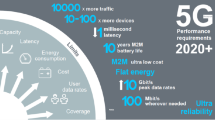Abstract
The three typical business scenarios of 5G are Enhanced Mobile Broadband, Massive Machine Type Communication, and Ultra-Reliable Low Latency Communication. Among them, Ultra-Reliable Low Latency Communication is one of the key application scenarios of 5G. Different from the traditional communication system which should pay more attention to the throughput, it requires the wireless and the carrier to have the ability of ultra-low delay and ultra-high reliability processing, and has high requirements on the network design. Therefore, based on the analysis of ITU and 3GPP’s demand for URLLC’s performance indicators, this paper discusses the key technologies of reducing URLLC’s delay and increasing its reliability, and proposes the design objectives of URLLC, as well as the key technologies of solving the delay and increasing URLLC’s reliability at design time, which provides a reference for designers and peers.
Access this chapter
Tax calculation will be finalised at checkout
Purchases are for personal use only
Similar content being viewed by others
References
GPP.3GPP TR 38.913: Study on Scenarios and Requirements for Next Generation Access Technologies (Release 15) (2018)
GPP. 3GPP TR 38.824: Study on physical layer enhancements for NR ultra-reliable and low latency case (URLLC) (Release 16) (2019)
Yi, Z., Xia, L., et al.: The URLLC standardization progresses in 3GPP. Mob. Commun. 44(2), 2–7 (2020)
Zhu, H., Lin, Y., et al.: Research on URLLC standard key technique and network architecture for 5G. Mob. Commun. 41(17), 28–33 (2017)
Liang, H., Han, X., Li, F.: Analysis on 5G URLLC wireless network deployment scheme. Des. Technol. Post Telecommun. (3), 15–18 (2020)
Krasilov, A.N., Khorov, E.M., Tsaritsyn, M.V.: On the capacity of a 5G network for URLLC. J. Commun. Technol. Electron. 64(12), 1513–1516 (2019)
Siddiqi, M.A., Yu, H., Joung, J.: 5G ultra-reliable low-latency communication. Implementation Challenges Oper. Issues IoT Devices 8(9) (2019)
IMT-2020(5G) Propulsion group, 5g vision and requirements white paper V1.0[Z] (2014)
Zhang, P., Pang, S., et al.: Research advance and development trend of wireless channel measurement technology in 5G high frequency band. Mob. Commun. 41(18), 67–72 (2017)
Wei, S., Wu, C.: Traffic latency charcterization and fingerprinting in mobile cellular networks. J. Comput. Res. Dev. 56(2), 363–374 (2019)
Xie, R., Lian, X.: Survey on computation offloading in mobile edge computing. J. Commun. (11), 138–155 (2018)
She, C., Yang, C., Quek, T.Q.: Radio resource management for ultra-reliable and low-latency communications. IEEE Commun. Mag. 55, 72–78 (2017)
Gao, Y., Li, L.: Analysis and research on URLLC Service Probability Delay Constraint And Resource Reservation. J. Beijing Univ. Posts Telecommun. 41(5), 98–102 (2018)
Chen, H., et al.: Ultra-reliable low latency cellular networks: use cases, challenges and approaches. IEEE Commun. Mag. 56, 119–125 (2018)
Öhmann, D., Awada, A., Viering, I., Simsek, M., Fettweis, G.P.: Achieving high availability in wireless networks by inter-frequency multi-connectivity. In: 2016 IEEE International Conference on Communications (ICC), pp. 1–7 (2016)
Wang, Y., Qiu, G., Lu, Z., et al.: The design of multi-TRP based URLLC transmission scheme in 5G. Appl. Electron. Tech. 45(8), 10–13 (2019)
Lu, W., Fang, Y.: The solutions and key technologies for URLLC ultra-low latency. Mob. Commun. 44(2), 8–14 (2020)
Li, X., Liu, J.: From LTE to 5G mobile communication system-technical principles and LabVIEW implementation. Tsinghua University Press (2019)
Ding, C.: Application scenarios and key technologies of 5G communication technology. Telecom World 26(5), 98–99 (2019)
Shirvanimoghaddam, M., Dohler, M., Johnson, S.J.: Massive non-orthogonal multiple access for cellular IoT: potentials and limitations. IEEE Commun. Mag. 55, 55–61 (2017)
Chen, H., Li, F.: Intelligent computer and applications. Res. Fifth Gener. Mob. Commun. Method Based eMBB mMTC uRLLC Scenarios 6(9), 13–21 (2019)
Popovski, P., et al.: Ultra-reliable low-latency communication (URLLC): principles and building blocks. IEEE Netw. 32, 16–23 (2018)
Chen, J.: Key technical specifications and development of 5G mobile communication. Telecom Eng. Technol. Stand. 31(6), 36–41 (2018)
Panigrahi, S.R., Bjorsell, N., Bengtsson, M.: Feasibility of large antenna arrays towards low latency ultra reliable communication. In: IEEE International Conference on Industrial Technology (2017)
Jing, L., Carvalho, E.D., Popovski, P., Martinez, A.O.: Design and performance analysis of non-coherent detection systems with massive receiver arrays. In: IEEE Transactions on Signal Processing, vol. 64, pp. 5000–5010 (2016)
Polyanskiy, Y., Poor, H.V., Verdú, S.: Channel coding rate in the finite blocklength regime. IEEE Trans. Inf. Theory 56, 2307 (2010)
Li, S.: 5G key technology introduction of NOMA. Electron. Prod. (4), 139–140 (2015)
Acknowledgements
This study was supported by the research project of Dehong Teachers’ College (XJ201812), Dr. Gan Jianhou workstation, Funded by the Science Research Fund of Yunnan Provincial Department of Education (2020J0835), Computer Science and Technology discipline innovation team building for intelligent education in ethnic areas (2020xhxtd07).
Author information
Authors and Affiliations
Corresponding author
Editor information
Editors and Affiliations
Rights and permissions
Copyright information
© 2020 Springer Nature Switzerland AG
About this paper
Cite this paper
Yuan, M., Song, D., Li, B. (2020). A Comparative Study on Key Technologies of Ultra-Reliable Low Latency Communication. In: Chen, X., Yan, H., Yan, Q., Zhang, X. (eds) Machine Learning for Cyber Security. ML4CS 2020. Lecture Notes in Computer Science(), vol 12487. Springer, Cham. https://doi.org/10.1007/978-3-030-62460-6_11
Download citation
DOI: https://doi.org/10.1007/978-3-030-62460-6_11
Published:
Publisher Name: Springer, Cham
Print ISBN: 978-3-030-62459-0
Online ISBN: 978-3-030-62460-6
eBook Packages: Computer ScienceComputer Science (R0)




